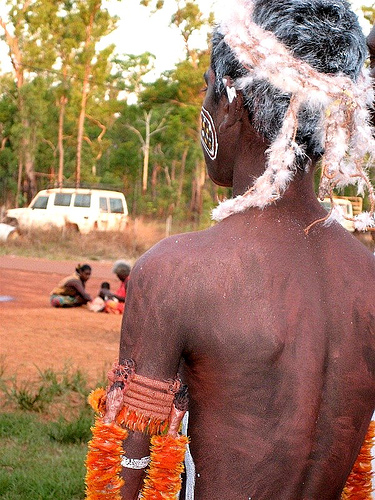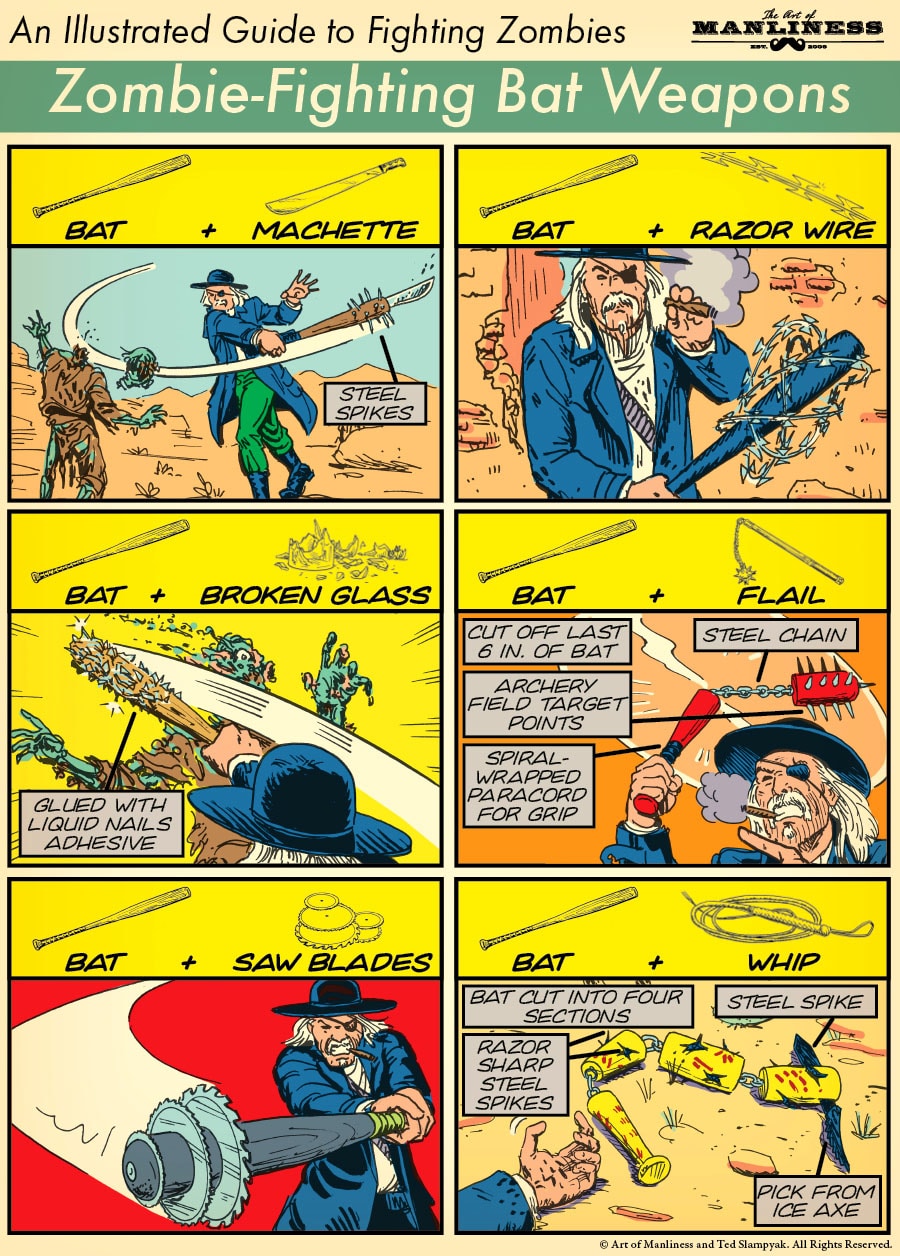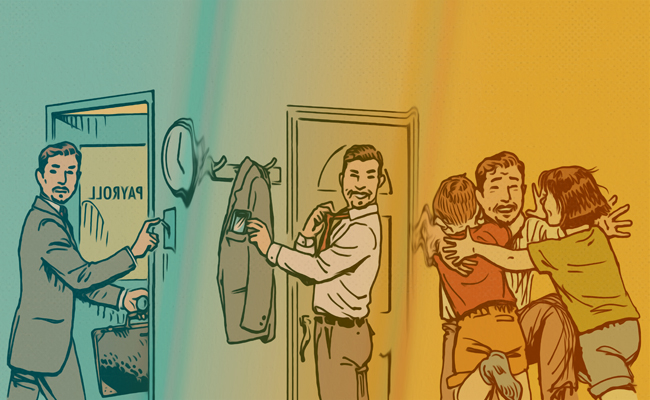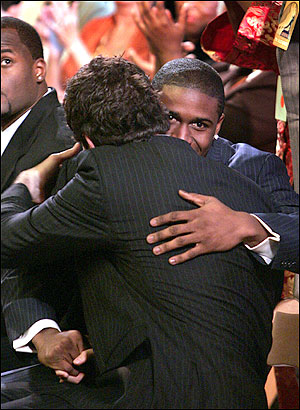At the heart of the modern crisis of manhood is the extension of adolescence, a boyhood which is stretching on for a longer and longer period of time. Once thought to end in a man’s 20s at the latest, men are extending their adolescence into their 30’s and in some especially sad cases, their 40’s.
But in some ways it’s not their fault. It’s the fault of a culture in which rites of passage have all but disappeared, leaving men adrift and lost, never sure when and if they’ve become men. Today’s men lack a community of males to initiate them into manhood and to recognize their new status.
Across time and place, cultures have inherently understood that without clear markers on the journey to manhood, males have a difficult time making the transition and can drift along indefinitely. Thus, rites of passage were clearly delineated in nearly every culture as one of the community’s most important rituals.
While almost every culture had a rite of passage ritual, there existed a great diversity in what these ceremonies consisted of. The common thread was an experience that involved emotional and physical pain and required a boy to pass the test of manhood: to show courage, endurance, and the ability to control one’s emotions.
The following are a few of the interesting (read:insane and crazy) rite of passage rituals that existed (and in some cases still exist) around the world. While they be quite offensive to our modern, Western sensibilities, each was born of different cultures’ beliefs of what made a man, a man. And you thought your Bar Mitzah was stressful.
Vanuatu Land Diving

Bungee jumping is for wusses… at least compared to the men who live in Vanuatu, a small island nation in the middle of the South Pacific. Here the men take place in a yearly harvest ritual called Land Diving.
Around April or May, villages will build crude wooden towers reaching heights of 100 feet or more. After the tower is completed, a few men will volunteer to scale it. The men then tie a vine first on a platform on the tower and then around their ankles. Summoning all the courage they have, the men dive from the platform headfirst. The divers reach speeds of 45 miles an hour as they plummet to the ground.
The goal of the jump is to land close enough to the ground that the diver’s shoulders touch the ground. Any miscalculation on the length of the vine means either serious injury or death.
Land diving among the Vanuatus goes back nearly 15 centuries. The purpose of the ritual is twofold. First, it’s performed as a sacrifice to their gods to ensure a bountiful yam crop. Second, it serves as a rite of passage to initiate the tribe’s boys into manhood. Boys as young as five years old will take part in the ritual which is often preceded by circumcision. The boys start out jumping low, but will work their way up as they get older. The higher a man goes, the manlier he is considered by the tribe.
Watch the divers make their plunge into manhood:
Mardudjara Aborigines Subincision
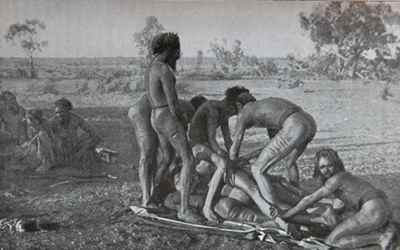
The rite of passage from boyhood to manhood of the Australian Mardudjara Aborigines consists of two parts: circumcision and sub-incision. Don’t know what sub-incision is? Read on. You’ll be wincing in pain.
When an Aborigine boy comes of age, usually around 15 or 16, the tribal elders will lead the boy to a fire and have him lie down next to it. Tribal members surround the boy while singing and dancing. Another group of men, called the Mourners, wail and cry while the circumcision is performed.
The tribal elder in charge of the circumcision sits on top of the boy’s chest facing his penis. He pulls up the foreskin and twists it so it can be cut off. Two men take turns cutting away the foreskin with knives that they’ve imbued with magical qualities. The boy bites down on a boomerang as the operation takes place.
When the circumcision is complete, the boy kneels on a shield that’s placed over the fire so the smoke can rise up and purify his wound.
While the boy sits there dazed and in pain, the tribal elders tell him to open his mouth and swallow some “good meat” without chewing it. The “good meat” is actually the boy’s freshly removed foreskin. After he’s swallowed a piece of his own wiener, the boy is told that he has eaten “his own boy” and that it will now grow inside him and make him strong.
Now comes the second part of the initiation — the sub-incision. A few months after the circumcision, the tribal elders take the young man again to a fire. An elder sits on the boy’s chest and takes ahold of the boy’s penis. Again, there are singers and men mourning at the ceremony. A small wooden rod is inserted into the urethra to act as a backing for the knife. The operator then takes a knife and makes a split on the underside of the penis from the frenulum (underneath the head of the penis) to near the scrotum.
After the sub-incision, the boy stands above the fire and allows his blood to drip into it. From now on the boy will have to squat when he urinates, just like a woman. In fact, some anthropologists posit that the sub-incision ceremony is done to simulate menstruation, allowing men to sympathize with the females of the tribe.
The ceremonies of the Mardudjara have slowly disappeared as contact with the modern world has increased and each successive generation becomes less willing to make a snack of their foreskin.
Hamar Cow Jumping
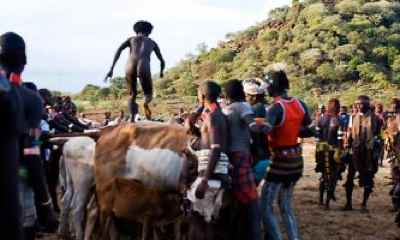
Imagine sitting down with your girlfriend’s dad to ask for his daughter’s hand in marriage. You’re nervous. Sweat gathers on your forehead. You make small talk, but finally manage to get the question out while your voice cracks.
The dad responds, “Sure! But you’ll have to jump over some cows first.”
If you’re a man living in the Hamar tribe of Ethiopia, this is exactly what you’d have to go through before you can get hitched. To become a man, you’ll have to jump over a herd of cattle.
The ceremony starts off with the tribe’s young girls jumping in unison. Usually these girls are relatives or good friends of the boy who is about to be initiated into manhood. Their metal jewelry clinks and clacks in a rhythmic beat. The girls will jump towards the maza — men who have already gone through the rite of passage — and hand them a green stick. The men use this green stick to lash at the backs of the girls while they continue to jump up and down. The lashing continues until blood is drawn. When the men are finished, the girls bow to them and jump away. The scars that form show that the women endured pain for the initiate during his passage into manhood.
After the whipping ceremony, the tribe forms a circle around a herd of cattle. Singing and chanting fills the air. Four of the biggest bulls are lined up side to side. In order for the ceremony to be valid, the bulls must be castrated. The initiate is brought to the cattle, naked except for a few cords he wears around his chest. The boy must jump onto the first bull and then run back and forth across the backs of the cattle three times. When he’s done, a shout is given and the boy is a maza, or man.
The Ancient Spartan Helot Killing
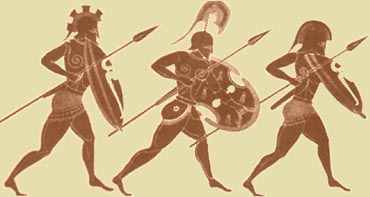
For ancient Spartans, becoming a soldier was the only way one could be recognized as a man. Military training began at age seven when boys would be taken from their families and placed in the Agoge system. For the next 10 years Spartan boys learned the skills necessary to become a trained killing machine.
When a Spartan youth turned 18, he completed his training. To graduate and be recognized as a man in his community, the boy had to undergo a cruel rite of passage called the krypteia. The young man would be sent to the countryside with only a knife and his wits. His object? To kill as many state-owned slaves, called helots, without being detected and return to his school in one piece. The young men would often hide during the day and make their attacks at night. In order to complete this rite of passage successfully, the young man had to call on all the training he received in the Agoge.
After successfully completing the krypteia, a Spartan man was expected to marry and continue killing for the state.
Satere-Mawe Bullet Ant Glove
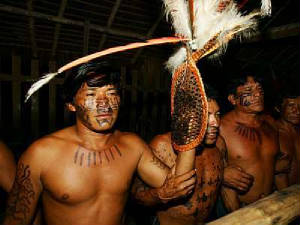
Deep in the heart of the Brazilian Amazon lives the Satere-Mawe tribe. To become a man in the Satere-Mawe, a boy must stick his hand in a glove woven with bullet ants and withstand their stings for over 10 minutes without making a noise.
According to the Schmidt Sting Index, the bullet ant has the most painful sting in the ant world. It’s described as “waves of throbbing, all consuming pain” that continues for over 24 hours. In fact, the locals call the ant, hormiga venticuatro because the pain from the sting lasts 24 hours.
Now if the sting from one bullet ant is that painful, imagine the pain you’d experience if you put on a glove made entirely of pissed-off bullet ants.
To make the glove, the tribesmen will knock out the bullet ants with a natural sedative. While the ants are docile, the elders proceed to make their torture device by weaving the ants into a glove made of leaves with the ants’ stingers facing inwards.
When the ants regain consciousness, the boys put on the gloves and face 10 minutes of pure, unadulterated hell. The copious amounts of venom the boy receives during the ordeal will temporarily paralyze his arm and leave him shaking uncontrollably for days.
This isn’t a one-time deal, either. A young boy may have to stick his hand in the bullet ant glove several more times before he’s considered a man. Each time he experiences the ordeal, the object is to remain as quiet as possible. It’s a test of manly endurance and stoicism that’s necessary to be effective warriors for the tribe.
Watch it in action:
Maasai Warrior Passage
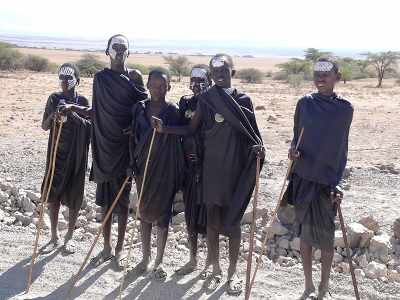
The Maasai of Kenya and Tanzania have a series of rites of passage that carry boys into manhood. Every 10 or 15 years a new warrior class will be initiated into the tribe. Boys between the ages of 10 and 20 are brought together from all across the country. Dozens of houses are built that will serve as the place of initiation. The night before the ceremony, the boys sleep outside in the forest. At dawn, they return to the little makeshift homestead for a day of singing and dancing. They drink a mixture of milk, cow’s blood, and alcohol and eat piles and piles of meat. After the festivities, boys who are of age (12-16) are ready to be circumcised.
The Emuratare is the most important ceremony in the life of a Maasai boy. Once circumcised, the tribe will consider him a man, warrior, and protector of his village. As the young man makes his way to where the elders will circumcise him, friends and family members will taunt the boy by saying things like “If you flinch, we will disown you.” The Maasai value bravery in their warriors and the circumcision is a boy’s first way to prove his courage even in the face of severe pain. It takes about 3 months for the circumcision to heal and during that time the young men wear black clothing and live in huts built by the women of the villiage. The Maasai boy is now warrior.
For the next 10 years the young men live together in an Emanyatta, or warriors camp. There they learn fighting, oratory, and animal husbandry. After 10 years, the young men take part in the Eunoto ceremony that marks the transition from warrior to senior warrior. After a Maasai has passed through the Eunoto, he can marry. The ceremony is basically several days of festivals, which ends with the initiate’s mother shaving his hair.
Mandan Hook Hanging
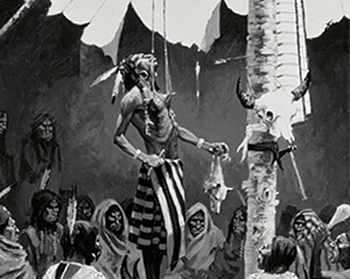
Native American tribes each had their own unique coming of age rituals for the men in the tribe. But few were as intense as that of the Mandans. Before his rite-of-passage, a Mandan boy fasted for 3 days to cleanse his body of impurities. Then, on the day of the ritual, elders of tribe would pierce the boy’s chest, shoulder, and back muscles with large wooden splints. Ropes, which extended from the roof of a hut, were then attached to the splints, and the young man was winched up into the air, his whole body weight suspended from the ropes. Despite the pain, the boy was not to cry out in pain. While hanging in the air, more splints were hammered through his arms and legs. Skulls of his dead grandfather and other ancestors were placed on the ends of the splints.
Eventually, the young man fainted from the loss of blood and the sheer pain of the torture. When the elders were sure he was unconscious, he was lowered down and the ropes were removed. Yet the splints were left in place. When the young man recovered consciousness, he offered his left pinky to the tribal elders to be sacrificed. He placed his finger on a block and had it swiftly chopped off. This was a gift to the gods and would enable the young man to become a powerful hunter. Finally, the young man ran inside a ring where his fellow villagers had gathered. As he ran, the villagers reached out and grabbed the still embedded splints, ripping them free. The splints weren’t allowed to be pulled out the way they had been hammered in, but had to be torn out in the opposite direction, causing the young man even greater pain and worse wounds. This concluded the day’s ceremony, and the boy was now a man.
Sambia of Papa New Guinea

In the small country of Papau New Guinea, over 1,000 different culture groups exist. Among them is the Sambia tribe, a group with perhaps the most insane rite of passage into manhood in the world.
The initiation begins at age seven with the separation of the boy from the mother. The boy will spend the rest of his young life only in the presence of men in an all male hut. The gender separation is taken to such extremes that boys and women use different walking paths around the village.
After being separated from the women, the young boy is subjected to several brutal hazing rituals. The first involves ceremonial bloodletting from the nose. The procedure is crude, but effective. The boy is held against a tree and stiff, sharp grasses and sticks are shoved up his nose until the blood starts flowing freely. Once the elders see blood, they let out a collective war cry. After the bloodletting, the boys undergo severe beatings and lashings. The purpose is to toughen up the boys and to prepare them to live as warriors.
As we’ve seen, ritual bloodletting is par for the course when it comes to male initiation. What sets the Sambia apart from other groups is the second part of their male rite of passage: semen drinking.
The Sambia believe that both men and women are born with a tingu. The tingu is a body part that allows for procreation. A woman’s tingu is ready for reproduction when she first menstruates. A man’s tingu is born shriveled and dried and the only way to fill it is to drink the “man milk,” or semen of other sexually mature men. They believe that by drinking the male essence of other men, the boys will become strong and virile. Done in the privacy of the forest, a boy will perform fellatio on young, usually unmarried men between the ages of 13 and 21. The boys are encouraged to “drink the male essence” as much as possible in order to become strong.
Around age 13, a young man has started puberty and another stage in the initiation begins. Another ritual nosebleed takes place along with some beatings to purify the young man. The boy is now considered a bachelor and will now provide the “man milk” to young boys just starting down the path of manhood.
Around age 20, a Sambia man is ready to marry, but before the nuptials take place, the tribal elders teach the young man the secrets to protect himself from the impurities of women. For example, when having intercourse, a man should stuff mint leaves in his nostril and chew on bark in order to mask the smell of his wife’s genitals. Moreover, when a man has sex with his wife, penetration shouldn’t be too deep as this will only increase the chances becoming polluted. Finally, after intercourse, a Sambia man must go bathe in mud in order to wash away any impurities he may have contracted from his wife. Even after marriage, a young Sambia man doesn’t spend very much time with his wife, but instead continues passing the time with the other men
The final rite of passage in the life of Sambian man is fatherhood. After his wife gives birth, a Sambia man is considered to have the full rights of masculinity.


